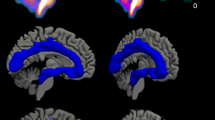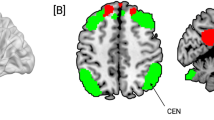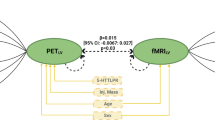Abstract
Seasonal affective disorder (SAD) is highly prevalent with rates of 1–6% and greater prevalence at more extreme latitudes; however, there are almost no direct brain investigations of this disorder. In health, serotonin transporter binding potential (5-HTT BPND), an index of 5-HTT levels, is greater throughout the brain in fall-winter compared with spring-summer. We hypothesized that in SAD, this seasonal variation would be greater in brain regions containing structures that regulate affect such as the prefrontal and anterior cingulate cortices (PFC and ACC). Furthermore, given the dimensional nature of SAD symptoms, it was hypothesized that seasonal fluctuation of 5-HTT BPND in the PFC and ACC would be greatest in severe SAD. Twenty SAD and twenty healthy participants underwent [11C]DASB positron emission tomography scans in summer and winter to measure seasonal variation in [11C]DASB 5-HTT BPND. Seasonal increases in [11C]DASB 5-HTT BPND were greater in SAD compared with healthy in the PFC and ACC, primarily due to differences between severe SAD and healthy (severe SAD vs healthy; Mann–Whitney U, U=42.5 and 37.0, p=0.005 and 0.003, respectively; greater magnitude in severe SAD of 35.10 and 14.23%, respectively), with similar findings observed in other regions (U=40.0–62.0, p=0.004–0.048; greater magnitude in severe SAD of 13.16–17.49%). To our knowledge, this is the first brain biomarker identified in SAD. This creates a new opportunity for phase 0 studies to target this phenotype and optimize novel prevention/treatment strategies for SAD.
Similar content being viewed by others
Log in or create a free account to read this content
Gain free access to this article, as well as selected content from this journal and more on nature.com
or
References
Bartko JJ, Kasper S (1989). Seasonal changes in mood and behavior: a cluster analytic approach. Psychiatry Res 28: 227–239.
Buchert R, Schulze O, Wilke F, Berding G, Thomasius R, Petersen K et al (2006). Is correction for age necessary in SPECT or PET of the central serotonin transporter in young, healthy adults? J Nucl Med 47: 38–42.
Caspi A, Hariri AR, Holmes A, Uher R, Moffitt TE (2010). Genetic sensitivity to the environment: the case of the serotonin transporter gene and its implications for studying complex diseases and traits. Am J Psychiatry 167: 509–527.
Chiuccariello L, Houle S, Miler L, Cooke RG, Rusjan PM, Rajkowska G, Levitan RD et al (2014). Elevated monoamine oxidase a binding during major depressive episodes is associated with greater severity and reversed neurovegetative symptoms. Neuropsychopharmacology 39: 973–980.
Deschwanden A, Karolewicz B, Feyissa AM, Treyer V, Ametamey SM, Johayem A et al (2011). Reduced metabotropic glutamate receptor 5 density in major depression determined by [(11)C]ABP688 PET and postmortem study. Am J Psychiatry 168: 727–734.
Eisenberg DP, Kohn PD, Baller EB, Bronstein JA, Masdeu JC, Berman KF (2010). Seasonal effects on human striatal presynaptic dopamine synthesis. J Neurosci 30: 14691–14694.
Faedda GL, Tondo L, Teicher MH, Baldessarini RJ, Gelbard HA, Floris GF (1993). Seasonal mood disorders. Patterns of seasonal recurrence in mania and depression. Arch Gen Psychiatry 50: 17–23.
Fujita M, Hines CS, Zoghbi SS, Mallinger AG, Dickstein LP, Liow JS et al (2012). Downregulation of brain phosphodiesterase type IV measured with 11C-(R)-rolipram positron emission tomography in major depressive disorder. Biol Psychiatry 72: 548–554.
Ginovart N, Wilson AA, Meyer JH, Hussey D, Houle S (2001). Positron emission tomography quantification of [11C]-DASB binding to the human serotonin transporter: modeling strategies. J Cereb Blood Flow Metab 21: 1342–1353.
Harmer CJ, Shelley NC, Cowen PJ, Goodwin GM (2004). Increased positive versus negative affective perception and memory in healthy volunteers following selective serotonin and norepinephrine reuptake inhibition. Am J Psychiatry 161: 1256–1263.
Harrison SJ, Tyrer AE, Levitan RD, Xu X, Houle S, Wilson AA et al (2015). Light therapy and serotonin transporter binding in the anterior cingulate and prefrontal cortex. Acta Psychiatr Scand 132: 379–388.
Ichise M, Liow JS, Lu JQ, Takano A, Model K, Toyama H et al (2003). Linearized reference tissue parametric imaging methods: application to [11C]DASB positron emission tomography studies of the serotonin transporter in human brain. J Cereb Blood Flow Metab 23: 1096–1112.
Jennings KA, Lesch KP, Sharp T, Cragg SJ (2010). Non-linear relationship between 5-HT transporter gene expression and frequency sensitivity of 5-HT signals. J Neurochem 115: 965–973.
Johansson C, Willeit M, Smedh C, Ekholm J, Paunio T, Kieseppä T et al (2003). Circadian clock-related polymorphisms in seasonal affective disorder and their relevance to diurnal preference. Neuropsychopharmacology 28: 734–739.
Kalbitzer J, Erritzoe D, Holst KK, Nielsen FA, Marner L, Lehel S et al (2010). Seasonal changes in brain serotonin transporter binding in short serotonin transporter linked polymorphic region-allele carriers but not in long-allele homozygotes. Biol Psychiatry 67: 1033–1039.
Kasper S, Wehr TA, Bartko JJ, Gaist PA, Rosenthal NE (1989). Epidemiological findings of seasonal changes in mood and behavior. A telephone survey of Montgomery County, Maryland. Arch Gen Psychiatry 46: 823–833.
Lam RW, Levitt AJ, Levitan RD, Enns MW, Morehouse R, Michalak EE et al (2006). The Can-SAD study: a randomized controlled trial of the effectiveness of light therapy and fluoxetine in patients with winter seasonal affective disorder. Am J Psychiatry 163: 805–812.
Lambert GW, Reid C, Kaye DM, Jennings GL, Esler MD (2002). Effect of sunlight and season on serotonin turnover in the brain. Lancet 360: 1840–1842.
Lavoie MP, Lam RW, Bouchard G, Sasseville A, Charron MC, Gagné AM et al (2009). Evidence of a biological effect of light therapy on the retina of patients with seasonal affective disorder. Biol Psychiatry 66: 253–258.
Lesch KP, Bengel D, Heils A, Sabol SZ, Greenberg BD, Petri S et al (1996). Association of anxiety-related traits with a polymorphism in the serotonin transporter gene regulatory region. Science 274: 1527–1531.
Levitan RD, Kaplan AS, Brown GM, Vaccarino FJ, Kennedy SH, Levitt AJ et al (1998). Hormonal and subjective responses to intravenous m-chlorophenylpiperazine in women with seasonal affective disorder. Arch Gen Psychiatry 55: 244–249.
Levitan RD, Masellis M, Lam RW, Kaplan AS, Davis C, Tharmalingam S et al (2006). A birth-season/DRD4 gene interaction predicts weight gain and obesity in women with seasonal affective disorder: a seasonal thrifty phenotype hypothesis. Neuropsychopharmacology 31: 2498–2503.
Line SJ, Barkus C, Rawlings N, Jennings K, McHugh S, Sharp T et al (2014). Reduced sensitivity to both positive and negative reinforcement in mice over-expressing the 5-hydroxytryptamine transporter. Eur J Neurosci 40: 3735–3745.
Logan J, Fowler JS, Volkow ND, Wang GJ, Ding YS, Alexoff DL (1996). Distribution volume ratios without blood sampling from graphical analysis of PET data. J Cereb Blood Flow Metab 16: 834–840.
Magnusson A (2000). An overview of epidemiological studies on seasonal affective disorder. Acta Psychiatr Scand 101: 176–184.
Meyer JH (2012). Neuroimaging markers of cellular function in major depressive disorder: implications for therapeutics, personalized medicine, and prevention. Clin Pharmacol Ther 91: 201–214.
Meyer JH, McMain S, Kennedy SH, Korman L, Brown GM, DaSilva JN et al (2003). Dysfunctional attitudes and 5-HT2 receptors during depression and self-harm. Am J Psychiatry 160: 90–99.
Meyer JH, Wilson AA, Sagrati S, Miler L, Rusjan P, Bloomfield PM et al (2009). Brain monoamine oxidase A binding in major depressive disorder: relationship to selective serotonin reuptake inhibitor treatment, recovery, and recurrence. Arch Gen Psychiatry 66: 1304–1312.
Modell JG, Rosenthal NE, Harriett AE, Krishen A, Asgharian A, Foster VJ et al (2005). Seasonal affective disorder and its prevention by anticipatory treatment with bupropion XL. Biol Psychiatry 58: 658–667.
Mouri A, Sasaki A, Watanabe K, Sogawa C, Kitayama S, Mamiya T et al (2012). MAGE-D1 regulates expression of depression-like behavior through serotonin transporter ubiquitylation. J Neurosci 32: 4562–4580.
Praschak-Rieder N, Willeit M, Wilson AA, Houle S, Meyer JH (2008). Seasonal variation in human brain serotonin transporter binding. Arch Gen Psychiatry 65: 1072–1078.
Praschak-Rieder N, Wilson AA, Hussey D, Carella A, Wei C, Ginovart N et al (2005). Effects of tryptophan depletion on the serotonin transporter in healthy humans. Biol Psychiatry 58: 825–830.
Quelch DR, Parker CA, Nutt DJ, Tyacke RJ, Erritzoe D (2012). Influence of different cellular environments on [3H]DASB radioligand binding. Synapse 66: 1035–1039.
Ressler KJ, Mayberg HS (2007). Targeting abnormal neural circuits in mood and anxiety disorders: from the laboratory to the clinic. Nat Neurosci 10: 1116–1124.
Rohan KJ, Nillni YI, Mahon JN, Roecklein KA, Sitnikov L, Haaga DA (2011). Cognitive vulnerability in moderate, mild, and low seasonality. J Nerv Ment Dis 199: 961–970.
Rosenthal NE, Sack DA, Gillin JC, Lewy AJ, Goodwin FK, Davenport Y et al (1984a). Seasonal affective disorder: a description of the syndrome and preliminary findings with light therapy. Arch Gen Psychiatry 41: 72–80.
Rosenthal N, Bradt G, Wehr T (1984b) Seasonal Pattern Assessment Questionnaire (SPAQ). National Institute of Mental Health: Bethesda, MD, USA.
Ruhé HG, Booij J, Reitsma JB, Schene AH (2009). Serotonin transporter binding with [123I]beta-CIT SPECT in major depressive disorder versus controls: effect of season and gender. Eur J Nucl Med Mol Imaging 36: 841–849.
Rusjan P, Mamo D, Ginovart N, Hussey D, Vitcu I, Yasuno F et al (2006). An automated method for the extraction of regional data from PET images. Psychiatry Res 147: 79–89.
Sanacora G, Gueorguieva R, Epperson CN, Wu YT, Appel M, Rothman DL et al (2004). Subtype-specific alterations of gamma-aminobutyric acid and glutamate in patients with major depression. Arch Gen Psychiatry 61: 705–713.
Schwartz PJ, Brown C, Wehr TA, Rosenthal NE (1996). Winter seasonal affective disorder: a follow-up study of the first 59 patients of the National Institute of Mental Health Seasonal Studies Program. Am J Psychiatry 153: 1028–1036.
Schwartz PJ, Murphy DL, Wehr TA, Garcia-Borreguero D, Oren DA, Moul DE et al (1997). Effects of meta-chlorophenylpiperazine infusions in patients with seasonal affective disorder and healthy control subjects. Diurnal responses and nocturnal regulatory mechanisms. Arch Gen Psychiatry 54: 375–385.
Setiawan E, Wilson AA, Mizrahi R, Rusjan PM, Miler L, Rajkowska G et al (2015). Role of translocator protein density, a marker of neuroinflammation, in the brain during major depressive episodes. JAMA Psychiatry 72: 268–275.
Spindelegger C, Stein P, Wadsak W, Fink M, Mitterhauser M, Moser U et al (2012). Light-dependent alteration of serotonin-1A receptor binding in cortical and subcortical limbic regions in the human brain. World J Biol Psychiatry 13: 413–422.
Talbot PS, Frankle WG, Hwang DR, Huang Y, Suckow RF, Slifstein M et al (2005). Effects of reduced endogenous 5-HT on the in vivo binding of the serotonin transporter radioligand 11C-DASB in healthy humans. Synapse 55: 164–175.
Wehr TA, Duncan WC Jr, Sher L, Aeschbach D, Schwartz PJ, Turner EH et al (2001). A circadian signal of change of season in patients with seasonal affective disorder. Arch Gen Psychiatry 58: 1108–1114.
Wilson A, Schmidt M, Ginovart N, Meyer J, Houle S (2000). Novel radiotracers for imaging the serotonin transporter by positron emission tomography: synthesis, radiosynthesis, in vitro and ex vivo evaluation of [11C]-labelled 2-(Phenylthio) araalkylamines. J Med Chem 43: 3103–3110.
Wu Y, Carson RE (2002). Noise reduction in the simplified reference tissue model for neuroreceptor functional imaging. J Cereb Blood Flow Metab 22: 1440–1452.
Acknowledgements
This research received project support from the Canadian Institutes of Health Research (CIHR) (grant number: RN158849-274056) and student salary support from Brain Canada. We thank the Campbell Family Mental Health Research Institute; technicians Alvina Ng, Laura Nguyen, Anusha Ravichandran and Hillary Bruce; chemistry staff Armando Garcia, Winston Stableford, and Min Wong; and engineers Terry Bell and Ted Harris-Brandts for their assistance with this project.
Author information
Authors and Affiliations
Corresponding author
Additional information
Supplementary Information accompanies the paper on the Neuropsychopharmacology website
PowerPoint slides
Rights and permissions
About this article
Cite this article
Tyrer, A., Levitan, R., Houle, S. et al. Increased Seasonal Variation in Serotonin Transporter Binding in Seasonal Affective Disorder. Neuropsychopharmacol 41, 2447–2454 (2016). https://doi.org/10.1038/npp.2016.54
Received:
Revised:
Accepted:
Published:
Issue date:
DOI: https://doi.org/10.1038/npp.2016.54
This article is cited by
-
Seasonality of brain function: role in psychiatric disorders
Translational Psychiatry (2023)
-
Brain monoamine oxidase A in seasonal affective disorder and treatment with bright light therapy
Translational Psychiatry (2018)
-
Seasonal variations in cardiovascular disease
Nature Reviews Cardiology (2017)



